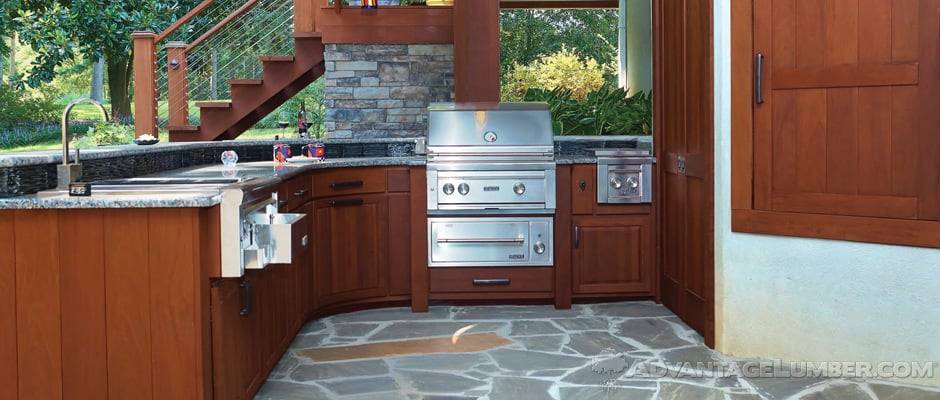
Building an outdoor kitchen is a major investment. You want to make sure you are using materials that are going to hold up to the outdoor environment as well as the abuse of kitchen wear and tear.
You are probably looking at spending thousands of dollars on top of the line stainless steel appliances for your outdoor kitchen.
The last thing you would want is to spend a lot of time and money on an outdoor kitchen and have your grill in your outdoor kitchen rust out after 5 years and force you to redo your outdoor kitchen.
Many homeowners want their appliances to sit in cabinets or an outdoor bar built out of a beautiful long lasting wood.
Woods You Should Not Use for an Outdoor Kitchen
We suggest staying away from softwoods such as pressure treated pine, cedar and redwood.
These softwoods are all susceptible to rot, wood boring insects and are can catch fire quickly. In addition they require yearly maintenance with waterproofing sealers that will peel off.
This will leave you scraping and sanding all the wood and then reapplying the sealer each year. Waterproofing sealers help keep water from penetrating the grain of softwoods which would lead to faster rot and decay.
Additionally your outdoor kitchen will more than likely be placed on a concrete slab foundation. Depending on the design of your outdoor kitchen your cabinets or bar will be sitting on top of the concrete.
Concrete wicks moisture so softwoods sitting on top of concrete will rot faster at the base.
These are just a few reasons why we don’t recommend these softwoods for an outdoor kitchen.
Best Woods for Outdoor Kitchens
There are a few species of wood that we’ve found to be proven to perform incredibly well in outdoor environments such as outdoor kitchens.
These species are Ipe, Cumaru, Tigerwood, Garapa and Massaranduba. They all come from South America and have proven to last up to 75 years or more with very low maintenance.
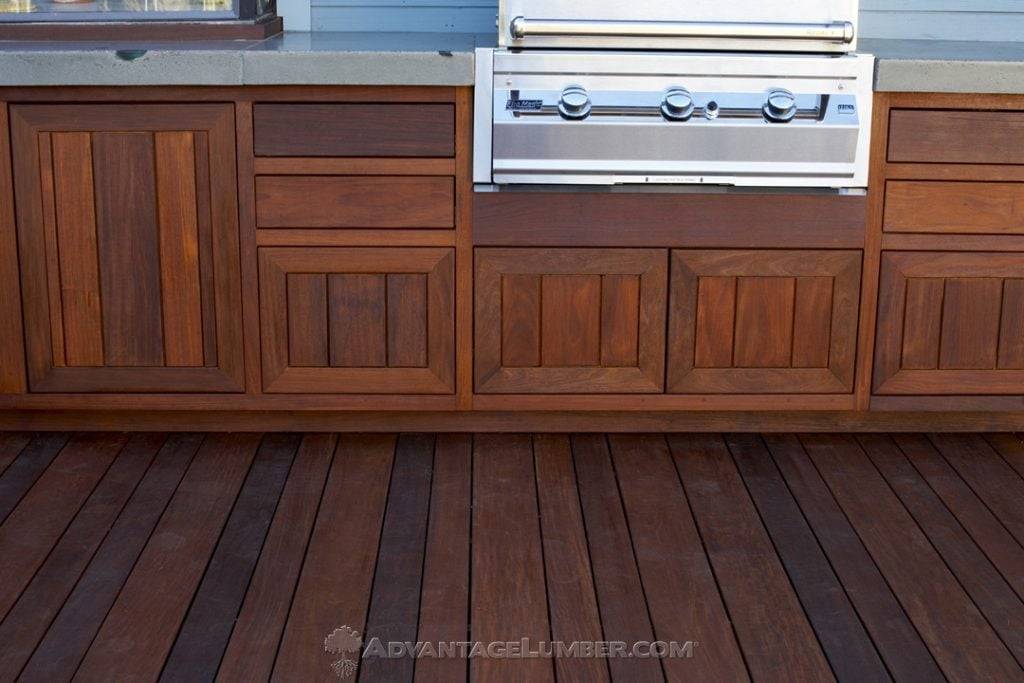
Above you’ll see a picture of an outdoor kitchen built with Ipe wood deck boards. The deck is also built with Ipe wood decking.
Ipe wood decking is one of the most durable, long lasting decking woods available. It is more durable than teak and is more cost effective as well.
It is also naturally resistant to mold, mildew, rot and decay, wood boring insects can not chew through the wood, It has a Class A rating against flame spread, does not splinter like softwoods and it has proven to last 75+ year on commercial boardwalks like Coney Island boardwalk in New York.
Here’s another outdoor kitchen built with Ipe Wood:
The second most durable wood we recommend for outdoor kitchens is Cumaru which is also known as Brazilian Teak.
Cumaru is almost identical to Ipe it’s just got a little more color variation which ranges from golden brown to a reddish brown. Ipe is more consistent in color which is a chocolate brown.
Many people are drawn to Cumaru because it’s typically 30% cheaper and also a very beautiful and durable wood. It has all the similar properties like Class A rating against flame spread which makes it an excellent wood for outdoor kitchens.
While we don’t have pictures of an outdoor kitchen built with Cumaru wood most of the jobs we supply are used to build decks.
Just like Ipe wood is most commonly used to build decks both of these woods are great for a wide array of outdoor projects.
Here’s a picture of a deck built with Cumaru:

Tigerwood Outdoor Kitchen
This is our 3rd most popular option for an exterior hardwood that is great for outdoor kitchens.
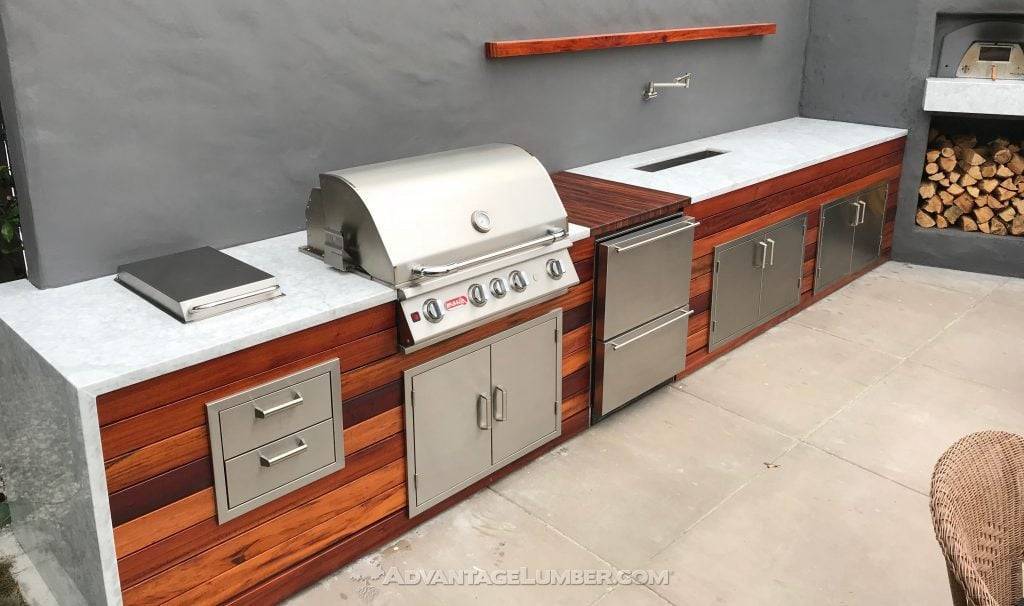
Tigerwood is not quite as dense as Ipe or Cumaru but it’s still a very dense and durable hardwood that’s great for outdoor use. In fact Tigerwood is more than double the Janka hardness compared to Teak.
These 3 wood species are the best woods that we recommend for outdoor kitchens.
When building an outdoor kitchen with wood you can often use short length boards depending on your design of course.
We sell short length boards at a significant cost savings that can save you up to 50 percent. Click here to view these discounted hardwoods
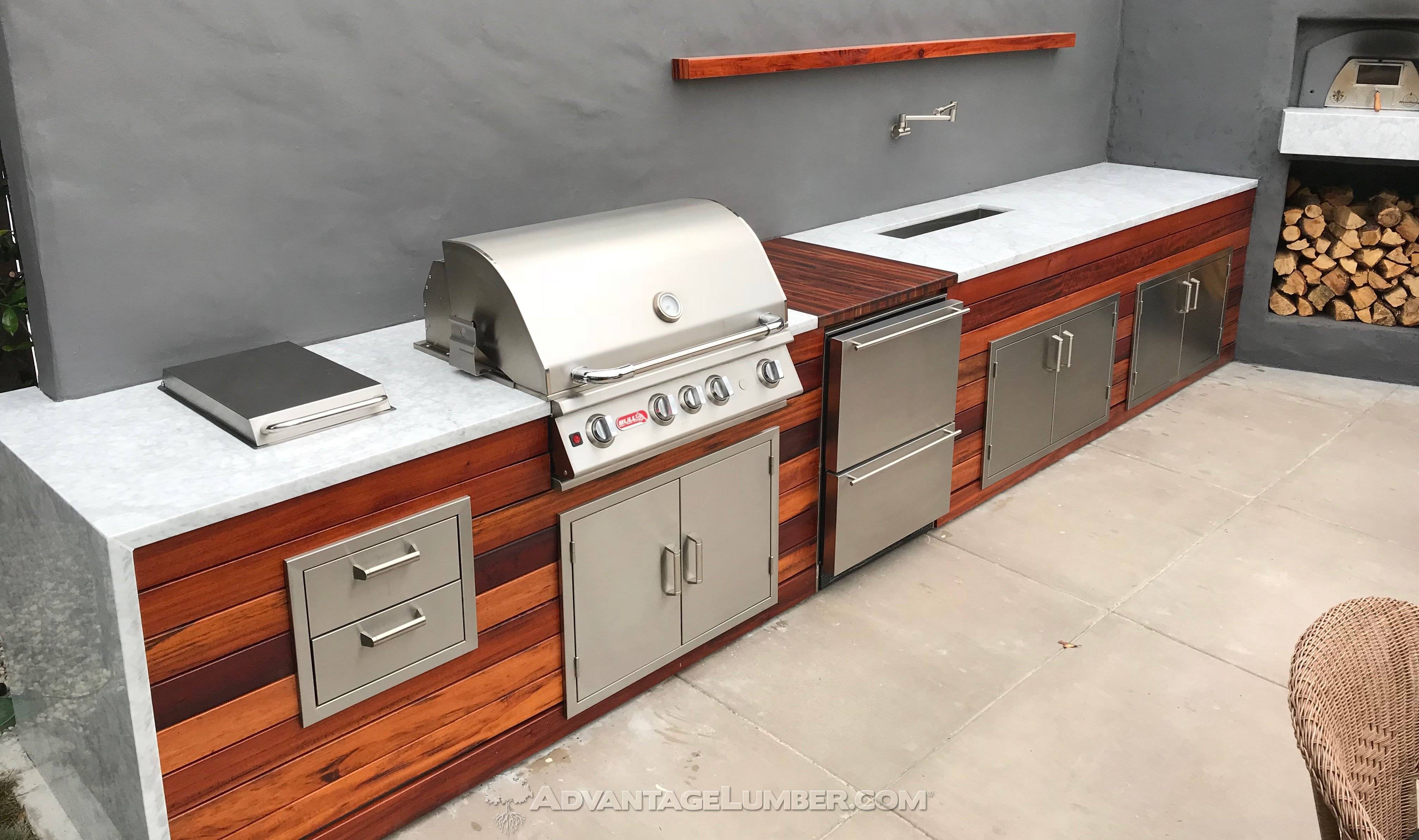
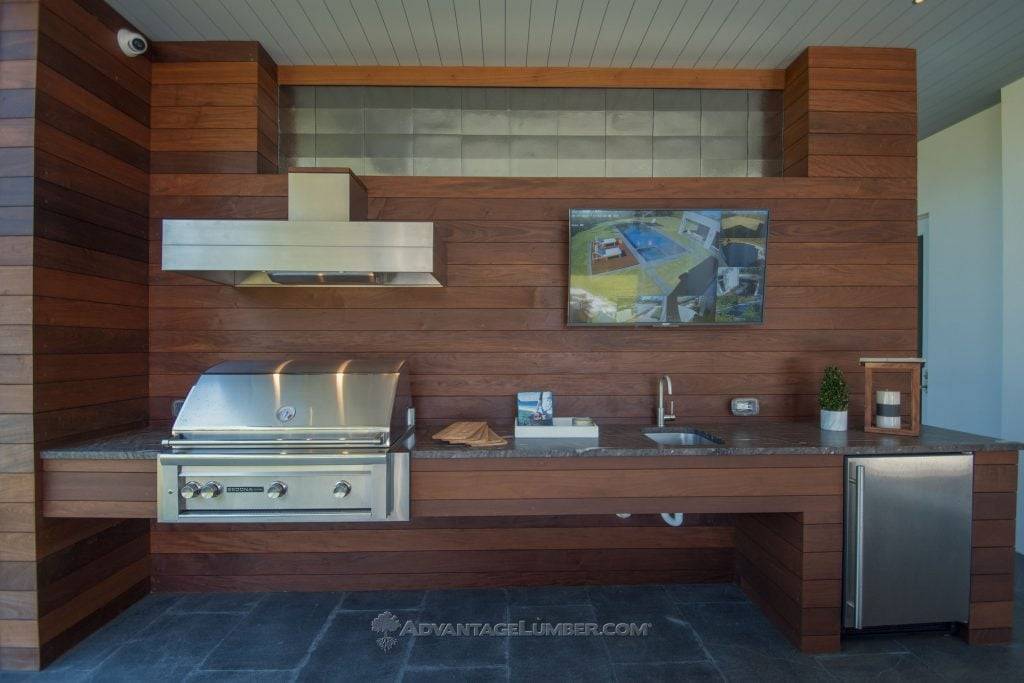
Love the wood, it’s beautiful.
what kind of wood is that? where did you buy it? i want to build my kitchen like that. is it safe due to fire from grill?
The woods comes from AdvantageLumber.com it is safe to use around grills but should not come in direct contact with very hot grills. If you purchase the appropriate grill you can safely use these wood species as most of the m have a Class A rating for flame spread.
any thoughts on a drawer box that will be inside the island with a front face made from the Brazilian wood? do you think any regular hardwood box can be used and then sealed to protect from moisture that might get at it? Thanks Much
The Brazilian wood itself is naturally protected from moisture without being sealed. If the entire drawer box is built with the Brazilian wood you just would not want water getting trapped in the drawer box. If you had water puddling in a drawer box it would cup and possibly break because the inside of the drawer box is saturated while the underside is bone dry. Anytime you have such varying differences in moisture content you will have issues. We do have plenty of customers though that use our woods for drawer fronts on outdoor kitchens as long as it’s built right and prevents water from getting inside you shouldn’t have a problem. You could use stainless drawers and attach a wood front if that works better for your application.
Can you use these woods as countertops for a grill area?
They’re certainly durable enough, but you’ll want to protect them somehow from grease stains.
For the outdoor cabinets, what are the inside of the cabinets framed with? Are they made completely out of Ipe? Or are just the drawer fronts and doors made from Ipe?
It depends on your budget and level of finish that you desire. You can certainly build them entirely out of Ipe, it would be more expensive but it would provide the same look and durability inside the cabinet as well as outside. There’s some people that use the steel framing and some that use pressure treated wood and finish off the inside with Ipe shelves.
I know Ipe grays out if not stained, what are you guys using on your outdoor kitchens as a staining or sealing product?
Also it appears like there hidden fasteners , is it just shiplap nailed through tounge?
We recommend Ipe Oil on all of our tropical hardwood decking species. We have many different profiles you could use. With shiplap you would need to screw through the tongue and once through the face. We sell plugs so you can hide the screw in the face. We also have a rainscreen siding profile that uses hidden fasteners so it installs faster and there’s now visible screw in the face of the boards. You can also go with standard deck boards but those would leave a gap in between. We can also do v-groove and regular tongue and groove or any custom profile you need.